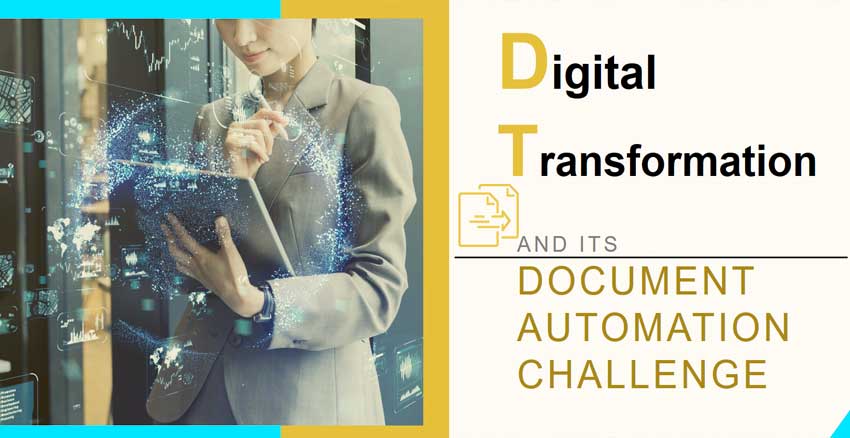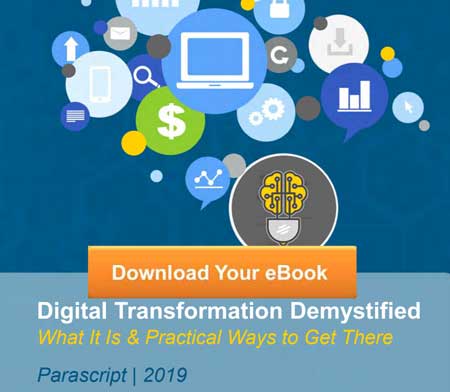Within the Digital Transformation (DX) landscape, there is a growing interest in document automation. We are going to dip our toes into the technology waters to discuss document automation and why it’s important in Part 2 of our DX series.
In Part 1 of our DX series, we discussed how Digital Transformation is about outcomes and not about technology. One of those outcomes is the ability to accelerate processes to improve many things such as customer convenience or revenue recognition.
Document Automation: Its Importance
First, the “why” document automation is important. If you’re employed within an organization of any type or size, you certainly deal with documents. The documents could be transaction-based in nature such as agreements, work orders, invoices or purchase orders. They could be related to communication such as emails. Or, they could be internal support or operations documents such as designs, management reports or meeting notes.
Regardless of the document type, we typically use documents to store and share information to support all kinds of processes, both internal and external. A few decades ago, any process that included documents required humans to collate and organize needed information. Increasingly, organizations make use of software—often called advanced capture—to perform common and routine document tasks such as sorting, organizing and data entry.
Customer Onboarding Example
Building upon the previous article using the customer onboarding process as an example, a legacy pre-DX workflow might include a prospective customer submitting an application and supporting documents by faxing, emailing or handing them over in-person. From here, a staff member receives and identifies each document and then reviews the information within each document, entering some of the data into a system of record. As a result, this process can take quite a long time depending upon staff availability, the number of documents and the amount of data entry required. If a document was missing, it might take days to notify the prospective customer.
One common objective of Digital Transformation is to improve processes in order to speed them up.
This process might work well, but can be costly in terms of labor and certainly is not speedy. One common objective of Digital Transformation is to improve processes in order to speed them up. The ability to do so can be critical. In the case of an insurance application, the ability to quickly arrive at a premium estimate can be the key to winning or losing a customer.
Keeping that Competitive Edge
Organizations relying upon manual processes and decades-old technology are not only running at higher cost, but are less competitive. We will not even discuss the errors common in manual processes that further bog-down organizations.
This is where document automation comes into play. The primary objective of these solutions is to eliminate as much manual intervention as possible, relying upon precisely-tuned systems that can reliably identify and organize documents, verify data and then automate data entry into other systems—all in as close to real-time as possible. With document automation, the ability to immediately respond to a prospective customer is enabled, regardless of time of day or the amount of documents submitted.
Benefits of Data Consistency
With document automation, organizations also benefit from the consistency of data. While human staff might review documentation and perform data entry in a variety of ways, automated systems can be configured to always do it in a single uniform manner. This enables organizations to remove unnecessary variability in data that is often at the root of many problems from the inability to shuttle data from one system to another to the inability to quickly locate and use required information.
Consistency of data and ability to use it in a more immediate manner without incurring significant costs are major cornerstones of almost any Digital Transformation project. Document automation enables your mobile-deposited check to be verified in near real-time. This means customers have quicker access to funds. Document automation accelerates and modernizes the mortgage origination process meaning loans close quicker which translates to both customer convenience and revenue acceleration for the financial institution.
DX Key Enabler
As organizations move from transformation of simple, highly-rote processes to those that are more complex (but often of higher value), use of document-based information is typically at the center and the need for document automation becomes a key enabler.
###
If you found this article interesting, you might find this eBook useful, Digital Transformation Demystified: What It Is & the Practical Ways to Get There.
You also might find this webinar available on-demand useful, too: “Digital Darwinism: Real Digital Transformation for Your Automation Projects.”






